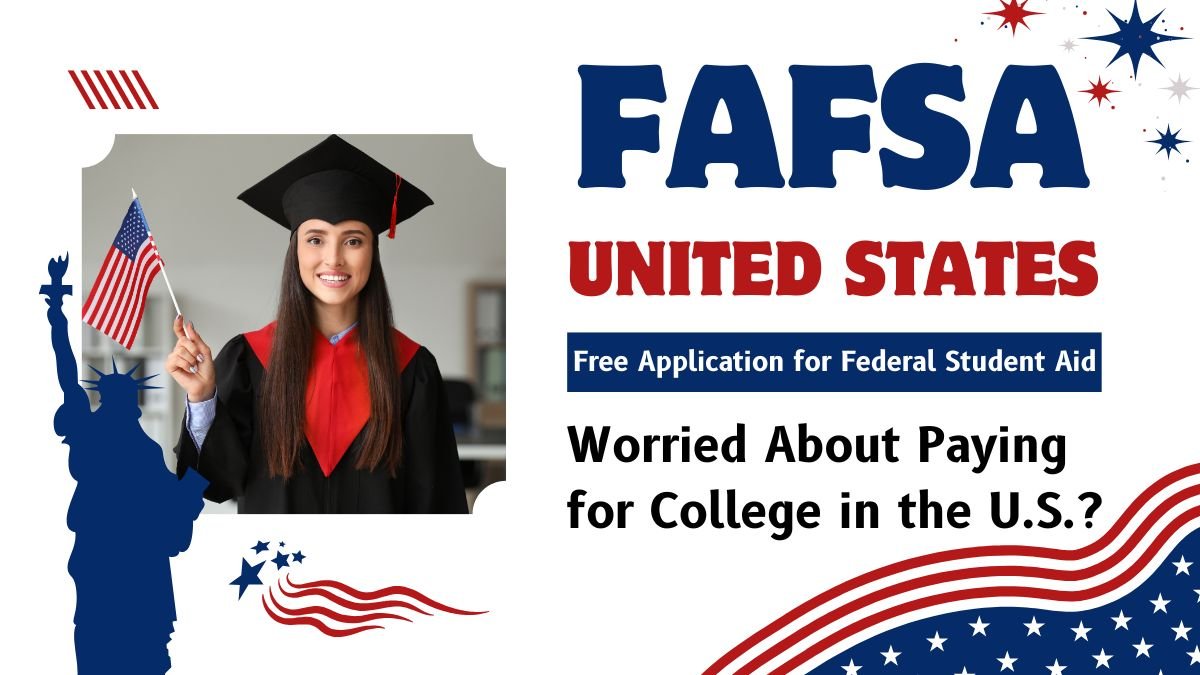If you’re an international student dreaming of studying in the U.S., you’re probably facing one big, scary question: How am I going to afford this?
Maybe you’ve been saving for years. Maybe your family is scraping together every penny. Or maybe you’re feeling lost and overwhelmed, unsure where to even begin. If that sounds like you, take a deep breath—you’re not alone. And there are ways to get help.
Let’s talk about FAFSA—what it is, how it works, and why even international students (yes, even you!) should still fill it out.
What Is FAFSA and Why Should You Care?
FAFSA stands for Free Application for Federal Student Aid. It’s a form used to apply for financial aid from the U.S. government—like grants, scholarships, work-study jobs, and loans.
Every year, the Department of Education gives out over $150 billion to help students pay for college in the U.S.
Here’s the catch: if you’re an international student, you’re technically not eligible for most federal aid unless you meet specific criteria. But don’t stop reading—there’s more to the story.
Filling out the FAFSA can still open doors.
Here’s what FAFSA helps with:
| Type of Aid | Examples |
|---|---|
| Grants (Free Money) | Pell Grant, FSEOG, TEACH Grant |
| Loans (To Repay) | Subsidized, Unsubsidized, PLUS Loans |
| Work-Study | On-campus and off-campus part-time jobs |
| Scholarships | Need-based or merit-based, from colleges |
Even if you don’t qualify for federal aid, many universities use your FAFSA form to decide if you can get state or school-specific scholarships.
Can International Students Apply for FAFSA?
Here’s the honest answer: Most international students don’t qualify for federal FAFSA aid because it requires a valid Social Security Number (SSN) and U.S. citizenship or eligible non-citizen status.
But—and it’s a big but—you should still fill out the FAFSA if:
- You’re applying for scholarships from U.S. colleges
- You’re classified as an eligible non-citizen (like a green card holder or refugee)
- You want to prove financial need to a college that uses FAFSA to calculate aid
Some schools even require it just to consider you for any form of support.
How to Fill Out the FAFSA (Even If You’re Not Eligible for Federal Aid)
Let’s break it down step-by-step. Don’t worry—it’s not as overwhelming as it seems.
Step 1: Start Early
- Research colleges that offer aid to international students
- Check deadlines (they vary by school!)
- Talk to a school counselor or admissions officer for help
Step 2: Fill Out the FAFSA Form
- Go to https://studentaid.gov
- Create your FSA ID (if you have a Social Security Number)
- No SSN? That’s okay—print the form and mail it in
Tip: Even if you don’t qualify for federal funds, submitting the FAFSA helps schools see your financial picture—and that could mean extra aid from the university itself.
Step 3: Review Your SAR (Student Aid Report)
- After you apply, you’ll get a report with the info you submitted
- Double-check everything—mistakes could hurt your chances
Step 4: Compare Financial Aid Offers
If you’re accepted to more than one college, compare the total cost (not just tuition) and aid packages. Ask yourself:
- Which one gives me more free money?
- Will I need to work or take out a loan?
- What’s the actual cost of living on campus?
Choose wisely. Your future is worth it.
Real Talk: Why FAFSA Still Matters for International Students
You might be wondering: Why should I bother if I’m not getting federal aid?
Here’s why:
- Many schools offer institutional aid—but only after they see your FAFSA
- You might qualify for state-level support if you’re a resident or meet certain conditions
- Some private scholarships also look at your FAFSA info
- It shows you’re serious about planning your finances
Even if you don’t get anything this year, filling out the FAFSA helps build your case for future aid.
FAFSA Deadlines (Don’t Miss Out!)
Each school has its own priority deadline, but here’s a rough timeline:
| Academic Year | FAFSA Opens | Final Deadline |
|---|---|---|
| 2025–2026 | October 1, 2024 | June 30, 2025 |
Apply as early as possible—many aid programs are first-come, first-served.
FAFSA for International Students: Quick Checklist
You should fill out FAFSA if you:
- Are a U.S. citizen or eligible non-citizen
- Want to qualify for school/state-based aid
- Need a way to show financial need
You’re likely NOT eligible if:
- You don’t have a valid SSN
- You’re on a student visa (F-1, J-1, etc.)
- You don’t meet the residency/citizenship criteria
But again—fill it out anyway if your school requires it or recommends it. It could still open doors.
FAQs About FAFSA for International Students
1. Can international students get FAFSA loans or grants?
Not directly. Most federal aid requires U.S. citizenship or eligible non-citizen status.
2. Should I still fill out the FAFSA if I’m not eligible?
Yes! Many colleges use the form to award other aid.
3. What if I don’t have a Social Security Number?
You can’t submit FAFSA online—but you can print and mail it.
4. Will FAFSA affect my visa or immigration status?
No. FAFSA is purely for financial aid. It doesn’t impact immigration.
5. Can I apply for financial aid every year?
Yes! You should renew your FAFSA annually to stay eligible for aid.
6. What are my options if I can’t get FAFSA aid?
Look into university scholarships, private grants, and on-campus jobs for international students.
Final Words
Money shouldn’t be the reason your dreams get delayed.
Yes, the system can be confusing and yes, FAFSA can feel out of reach. But you’re not alone in this. Thousands of international students have walked this path—and found a way forward.









